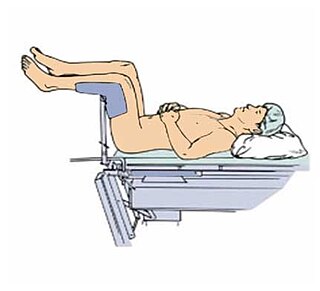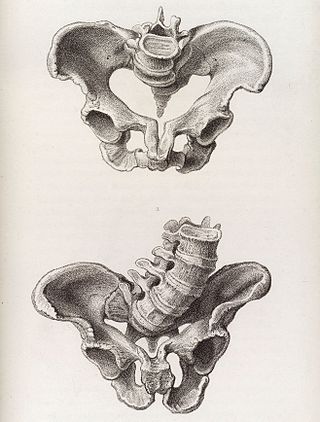
Midwifery is the health science and health profession that deals with pregnancy, childbirth, and the postpartum period, in addition to the sexual and reproductive health of women throughout their lives. In many countries, midwifery is a medical profession. A professional in midwifery is known as a midwife.

Childbirth, also known as labour, parturition and delivery, is the completion of pregnancy where one or more babies exits the internal environment of the mother via vaginal delivery or caesarean section. In 2019, there were about 140.11 million human births globally. In the developed countries, most deliveries occur in hospitals, while in the developing countries most are home births.

The perineum in mammals is the space between the anus and the genitals. The human perineum is between the anus and scrotum in the male or between the anus and vulva in the female. The perineum is the region of the body between the pubic symphysis and the coccyx, including the perineal body and surrounding structures. The perineal raphe is visible and pronounced to varying degrees. The perineum is an erogenous zone. This area is also known as the taint or gooch in American slang.

Episiotomy, also known as perineotomy, is a surgical incision of the perineum and the posterior vaginal wall generally done by an obstetrician. This is usually performed during the second stage of labor to quickly enlarge the aperture, allowing the baby to pass through. The incision, which can be done from the posterior midline of the vulva straight toward the anus or at an angle to the right or left, is performed under local anesthetic, and is sutured after delivery.

The lithotomy position is a common position for surgical procedures and medical examinations involving the pelvis and lower abdomen, as well as a common position for childbirth in Western nations. The lithotomy position involves the positioning of an individual's feet above or at the same level as the hips, with the perineum positioned at the edge of an examination table. References to the position have been found in some of the oldest known medical documents including versions of the Hippocratic oath ; the position is named after the ancient surgical procedure for removing kidney stones and bladder stones via the perineum. The position is perhaps most recognizable as the 'often used' position for childbirth: the patient is laid on the back with knees bent, positioned above the hips, and spread apart through the use of stirrups.
Natural childbirth is childbirth without routine medical interventions, particularly anesthesia. Natural childbirth arose in opposition to the techno-medical model of childbirth that has recently gained popularity in industrialized societies. Natural childbirth attempts to minimize medical intervention, particularly the use of anesthetic medications and surgical interventions such as episiotomies, forceps and ventouse deliveries and caesarean sections. Natural childbirth may occur during a physician or midwife attended hospital birth, a midwife attended homebirth, or an unassisted birth. The term "natural childbirth" was coined by obstetrician Grantly Dick-Read upon publication of his book Natural Childbirth in the 1930s, which was followed by the 1942 Childbirth Without Fear.

Antenatal perineal massage (APM) or Birth Canal Widening (BCW) is the / massage of a pregnant woman's perineum – the skin and deep tissues around the opening to the vagina or, performed in the 4 to 6 weeks before childbirth, i.e., 34 weeks or sooner and continued weekly until birth. The practice aims to gently mimic the 'massaging' action of a baby's head on the opening to the birth canal (vagina) prior to birth, so works with nature, to achieve the 10 cm diameter opening without using the back of baby's head, i.e., doing some of the hard work of labour (birth) before the start of labour, making birth less stressful on the baby and mother. The intention is also to attempt to: eliminate the need for an episiotomy during an instrument delivery; to prevent tearing of the perineum during birth and in this way avoid infection, helping to keep antibiotics working into the future. This technique uses Plastic Surgeons 'skin tissue expansion' principle, to aid a natural birth.

Vacuum extraction (VE), also known as ventouse, is a method to assist delivery of a baby using a vacuum device. It is used in the second stage of labor if it has not progressed adequately. It may be an alternative to a forceps delivery and caesarean section. It cannot be used when the baby is in the breech position or for premature births. The use of VE is generally safe, but it can occasionally have negative effects on either the mother or the child. The term ventouse comes from the French word for "suction cup".

Epidural administration is a method of medication administration in which a medicine is injected into the epidural space around the spinal cord. The epidural route is used by physicians and nurse anesthetists to administer local anesthetic agents, analgesics, diagnostic medicines such as radiocontrast agents, and other medicines such as glucocorticoids. Epidural administration involves the placement of a catheter into the epidural space, which may remain in place for the duration of the treatment. The technique of intentional epidural administration of medication was first described in 1921 by Spanish military surgeon Fidel Pagés.

Water birth is labor and sometimes delivery that occurs in water, usually a birthing pool. The American College of Obstetricians and Gynecologists does not recommend birthing in water as the safety has not been determined. Proponents believe childbirth in water results in a more relaxed, less painful experience that promotes a midwife-led model of care. Critics argue that the safety of waterbirth has not been scientifically proven and that a wide range of adverse neonatal outcomes have been documented, including increased mother or child infections and the possibility of infant drowning. A 2018 Cochrane Review of water immersion in the first stages of labor found evidence of fewer epidurals and few adverse effects but insufficient information regarding giving birth in water.

Obstructed labour, also known as labour dystocia, is the baby not exiting the pelvis because it is physically blocked during childbirth although the uterus contracts normally. Complications for the baby include not getting enough oxygen which may result in death. It increases the risk of the mother getting an infection, having uterine rupture, or having post-partum bleeding. Long-term complications for the mother include obstetrical fistula. Obstructed labour is said to result in prolonged labour, when the active phase of labour is longer than 12 hours.

Obstetrical forceps are a medical instrument used in childbirth. Their use can serve as an alternative to the ventouse method.
An asynclitic birth or asynclitism are terms used in obstetrics to refer to childbirth in which there is malposition of the head of the fetus in the uterus, relative to the birth canal. Asynclitic presentation is different from a shoulder presentation, in which the shoulder is presenting first. Many babies enter the pelvis in an asynclitic presentation, and most asynclitism corrects spontaneously as part of the normal birthing process.
A postpartum disorder or puerperal disorder is a disease or condition which presents primarily during the days and weeks after childbirth called the postpartum period. The postpartum period can be divided into three distinct stages: the initial or acute phase, 6–12 hours after childbirth; subacute postpartum period, which lasts two to six weeks, and the delayed postpartum period, which can last up to six months. In the subacute postpartum period, 87% to 94% of women report at least one health problem. Long term health problems are reported by 31% of women.

A perineal tear is a laceration of the skin and other soft tissue structures which, in women, separate the vagina from the anus. Perineal tears mainly occur in women as a result of vaginal childbirth, which strains the perineum. It is the most common form of obstetric injury. Tears vary widely in severity. The majority are superficial and may require no treatment, but severe tears can cause significant bleeding, long-term pain or dysfunction. A perineal tear is distinct from an episiotomy, in which the perineum is intentionally incised to facilitate delivery. Episiotomy, a very rapid birth, or large fetal size can lead to more severe tears which may require surgical intervention.

A birthing chair, also known as a birth chair, is a device that is shaped to assist a woman in the physiological upright posture during childbirth. It is intended to provide balance and support. If backless, it is known as a birth stool.
Obstetric anesthesia or obstetric anesthesiology, also known as ob-gyn anesthesia or ob-gyn anesthesiology, is a sub-specialty of anesthesiology that provides peripartum pain relief (analgesia) for labor and anesthesia for cesarean deliveries ('C-sections').

Pain management during childbirth is the partial treatment and a way of reducing any pain that a woman may experience during labor and delivery. The amount of pain a woman feels during labor depends partly on the size and position of her baby, the size of her pelvis, her emotions, the strength of the contractions, and her outlook. Tension increases pain during labor. Virtually all women worry about how they will cope with the pain of labor and delivery. Childbirth is different for each woman and predicting the amount of pain experienced during birth and delivery can not be certain.
The postpartum physiological changes are those expected changes that occur in the woman's body after childbirth, in the postpartum period. These changes mark the beginning of the return of pre-pregnancy physiology and of breastfeeding. Most of the time these postnatal changes are normal and can be managed with medication and comfort measures, but in a few situations complications may develop. Postpartum physiological changes may be different for women delivering by cesarean section. Other postpartum changes, may indicate developing complications such as, postpartum bleeding, engorged breasts, postpartum infections.

Emergency childbirth is the precipitous birth of an infant in an unexpected setting. In planned childbirth, mothers choose the location and obstetric team ahead of time. Options range from delivering at home, at a hospital, a medical facility or a birthing center. Sometimes, birth can occur on the way to these facilities, without a healthcare team. The rates of unplanned childbirth are low. If the birth is imminent, emergency measures may be needed. Emergency services can be contacted for help in some countries.















